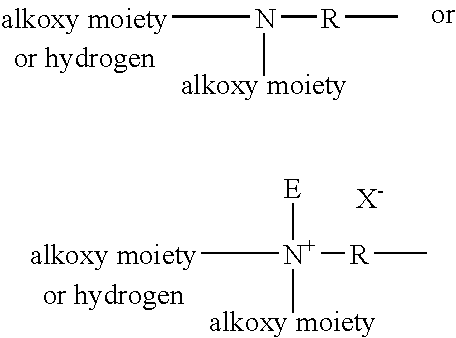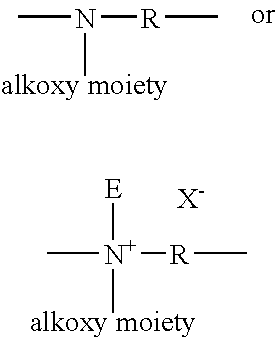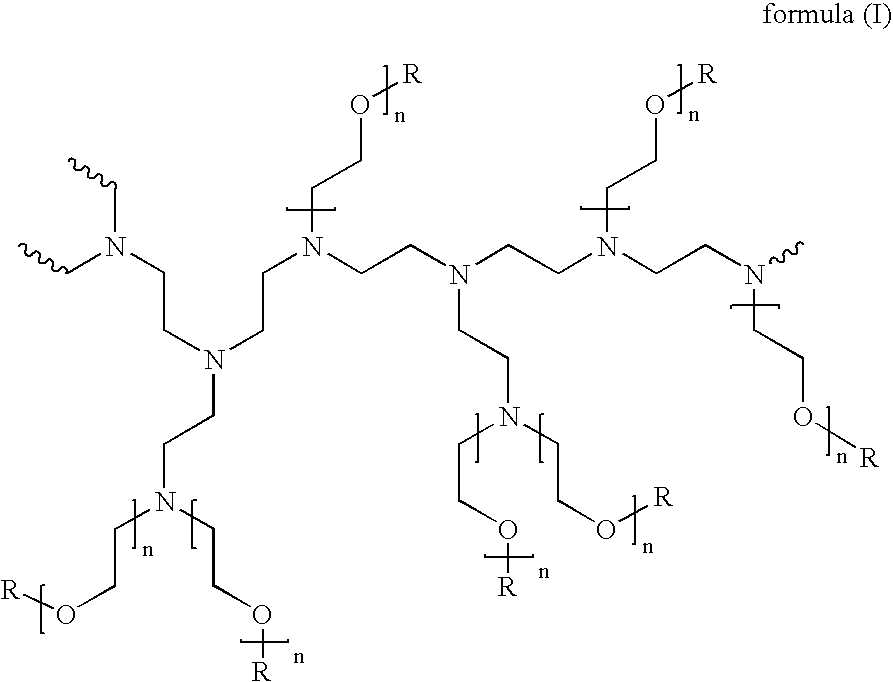Liquid laundry detergent compositions with modified polyethyleneimine polymers and lipase enzyme
a technology of modified polyethyleneimine and lipase enzyme, which is applied in the direction of detergent compositions, soap detergent compositions, chemistry apparatus and processes, etc., can solve the problem that many surfactant-based products still do not achieve complete removal of greasy/oily soils
- Summary
- Abstract
- Description
- Claims
- Application Information
AI Technical Summary
Benefits of technology
Problems solved by technology
Method used
Image
Examples
example 1
Polyethyleneimine of Molecular Weight 5000 (Hereinafter PEI5000) Modified with 7 Ethoxy Moieties (EO) per Nitrogen-Hydrogen Bond (NH)
a) Treatment of PEI5000 with 1 EO / NH
[0038] Heat to 80° C. in a 2 L reactor 900 g of a 50 wt % aqueous solution of PEI5000 (backbone molecular weight 5000) and strip with nitrogen thrice (until a pressure of 500 kPa (5 bar) is obtained). Increase the temperature to 90° C. and add 461 g ethylene oxide until pressure rises to 500 kPa (5 bar). Remove the volatile components after 2 hours by stripping with nitrogen at 80° C. or vacuum of 50 kPa (500 mbar) at 80° C. Collect 1345 g of a 68% aqueous solution, which contains PEI5000 with 1 EO / NH
b) Alkoxylation of PEI5000 with 1 EO / NH in the Presence of a Solvent
[0039] Treat in a 2 l reactor 362 g of a 68.5% aqueous solution from step (a) with 31 g of 40% aqueous solution of potassium hydroxide and 300 g xylene and and strip with nitrogen thrice (until a pressure of 500 kPa (5 bar) is obtained). Remove wat...
example 2
Polyethyleneimine of Molecular Weight 5000 Modified with 10 Ethoxy Moieties (EO) and 7 Propoxy Moieties (PO) per Nitrogen-Hydrogen Bond (NH)
a) Treatment of PEI5000 with 1 EO / NH as in Example 1.
b) Alkoxylation of PEI5000 with 1 EO / NH
[0040] Treat in a 2 l reactor 163 g of a 68.4% the aqueous solution from step (a) with 13.9 g of 40% an aqueous solution of potassium hydroxide, heat to 70° C. and strip with nitrogen thrice (until a pressure of 500 kPa (5 bar) is obtained). Remove water during a 4 hour time period at 120° C. and vacuum of 1 kPa (10 mbar). Add 506 g ethylene oxide at 120° C. until pressure of 800 kPa (8 bar) is obtained. Stir for 4 hours at 120° C. Strip with nitrogent 120° C. Add 519 g propylene oxide at 120° C. until pressure of 800 kPa (8 bar) is obtained. Stir for 4 hours at 102° C. Remove volatile components by stripping with nitrogen at 80° C. or vacuum of 50 kPa (500 mbar) at 80° C. Collect 1178 g of a bright brownish viscous liquid (amine titer: 0.9276 mmol / g...
example 3
Polyethyleneimine of Molecular Weight 5000 Modified with 9.9 Ethoxy Moieties (EO) and 3.5 Propoxy Moieties (PO) per Nitrogen-Hydrogen (NH) Bond
a) Treatment of PEI5000 with 1 EO / NH as in Example 1.
b) Alkoxylation of PEI5000 with 1 EO / NH
[0042] Treat in a 2 L reactor 321 g of a 69.2% aqueous solution from (a) with 28 g of 40% aqueous solution of potassium hydroxide, heat to 80° C. and strip with nitrogen thrice (until pressure of 500 kPa (5 bar) is obtained). Remove water during the next 3 hours while maintaining a temperature of 120° C. and vacuum of 1 kPa (10 mbar). Add 1020 g ethylene oxide at 120° C. until pressure of 800 kPa (8 bar) is obtained. Stir for 4 hours at 120° C. Remove the volatile components by stripping with nitrogen at 80° C. or under a vacuum of 50 kPa (500 mbar) at 80° C. Collect 1240 g of a brownish viscous liquid, which contains PEI 5000 with 9.9 EO / NH (amine titer: 1.7763 mmol / g; pH value at 1% weight in water 11.3). Strip with nitrogen (until pressure of 5...
PUM
| Property | Measurement | Unit |
|---|---|---|
| pH | aaaaa | aaaaa |
| pressure | aaaaa | aaaaa |
| pressure | aaaaa | aaaaa |
Abstract
Description
Claims
Application Information
 Login to View More
Login to View More - R&D
- Intellectual Property
- Life Sciences
- Materials
- Tech Scout
- Unparalleled Data Quality
- Higher Quality Content
- 60% Fewer Hallucinations
Browse by: Latest US Patents, China's latest patents, Technical Efficacy Thesaurus, Application Domain, Technology Topic, Popular Technical Reports.
© 2025 PatSnap. All rights reserved.Legal|Privacy policy|Modern Slavery Act Transparency Statement|Sitemap|About US| Contact US: help@patsnap.com



